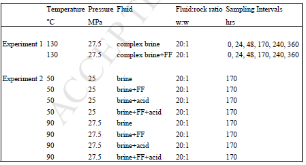Empirically assessing the potential release of rare earth elements from black shale under simulated hydraulic fracturing conditions
Abstract
Rare earth elements (REEs) are economically important to modern society and the rapid growth of technologies dependent on REEs has placed considerable economic pressure on their sourcing. This study addresses whether REEs could be released as a byproduct of natural gas extraction from a series of experiments that were designed to simulate hydraulic fracturing of black shale under various pressure (25 and 27.5 MPa) and temperature (50, 90, 130 °C) conditions. The dissolved REEs in the reacted fluids displayed no propensity for the REEs to be released from black shale under high pressure and temperature conditions, a result that is consistent across the different types of fluids investigated. Overall, there was a net loss of REEs from the fluid. These changes in dissolved REEs were greatest at the moment the fluids first contacted the shale and before the high temperature and high pressure conditions were imposed, although the magnitude of these changes (10-4 μg/g) were small compared to the magnitude of the total REE content present in the solid shale samples (102 μg/g). These results highlight the variability and complexity of hydraulic fracturing systems and indicate that REE may not serve as robust tracers for fracturing fluid-shale reactions. Additionally, themore »
- Authors:
-
- Oregon State Univ., Corvallis, OR (United States)
- National Energy Technology Lab. (NETL), Albany, OR (United States)
- National Energy Technology Lab. (NETL), Pittsburgh, PA, (United States)
- Publication Date:
- Research Org.:
- National Energy Technology Lab. (NETL), Pittsburgh, PA, (United States)
- Sponsoring Org.:
- USDOE
- OSTI Identifier:
- 1433641
- Report Number(s):
- NETL-PUB-20593
Journal ID: ISSN 1875-5100; PII: S1875510017304407
- Resource Type:
- Accepted Manuscript
- Journal Name:
- Journal of Natural Gas Science and Engineering
- Additional Journal Information:
- Journal Volume: 50; Journal Issue: C; Journal ID: ISSN 1875-5100
- Publisher:
- Elsevier
- Country of Publication:
- United States
- Language:
- English
- Subject:
- 03 NATURAL GAS
Citation Formats
Yang, Jon, Verba, Circe, Torres, Marta, and Hakala, J. Alexandra. Empirically assessing the potential release of rare earth elements from black shale under simulated hydraulic fracturing conditions. United States: N. p., 2018.
Web. doi:10.1016/j.jngse.2017.09.011.
Yang, Jon, Verba, Circe, Torres, Marta, & Hakala, J. Alexandra. Empirically assessing the potential release of rare earth elements from black shale under simulated hydraulic fracturing conditions. United States. https://doi.org/10.1016/j.jngse.2017.09.011
Yang, Jon, Verba, Circe, Torres, Marta, and Hakala, J. Alexandra. Thu .
"Empirically assessing the potential release of rare earth elements from black shale under simulated hydraulic fracturing conditions". United States. https://doi.org/10.1016/j.jngse.2017.09.011. https://www.osti.gov/servlets/purl/1433641.
@article{osti_1433641,
title = {Empirically assessing the potential release of rare earth elements from black shale under simulated hydraulic fracturing conditions},
author = {Yang, Jon and Verba, Circe and Torres, Marta and Hakala, J. Alexandra},
abstractNote = {Rare earth elements (REEs) are economically important to modern society and the rapid growth of technologies dependent on REEs has placed considerable economic pressure on their sourcing. This study addresses whether REEs could be released as a byproduct of natural gas extraction from a series of experiments that were designed to simulate hydraulic fracturing of black shale under various pressure (25 and 27.5 MPa) and temperature (50, 90, 130 °C) conditions. The dissolved REEs in the reacted fluids displayed no propensity for the REEs to be released from black shale under high pressure and temperature conditions, a result that is consistent across the different types of fluids investigated. Overall, there was a net loss of REEs from the fluid. These changes in dissolved REEs were greatest at the moment the fluids first contacted the shale and before the high temperature and high pressure conditions were imposed, although the magnitude of these changes (10-4 μg/g) were small compared to the magnitude of the total REE content present in the solid shale samples (102 μg/g). These results highlight the variability and complexity of hydraulic fracturing systems and indicate that REE may not serve as robust tracers for fracturing fluid-shale reactions. Additionally, the results suggest that significant quantities of REEs may not be byproducts of hydraulically fractured shales.},
doi = {10.1016/j.jngse.2017.09.011},
journal = {Journal of Natural Gas Science and Engineering},
number = C,
volume = 50,
place = {United States},
year = {Thu Feb 01 00:00:00 EST 2018},
month = {Thu Feb 01 00:00:00 EST 2018}
}
Web of Science
Figures / Tables:
 Table 1: Experiment conditions
Table 1: Experiment conditions

 Search WorldCat to find libraries that may hold this journal
Search WorldCat to find libraries that may hold this journal